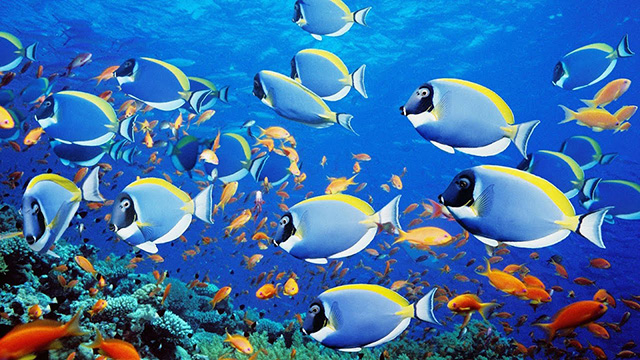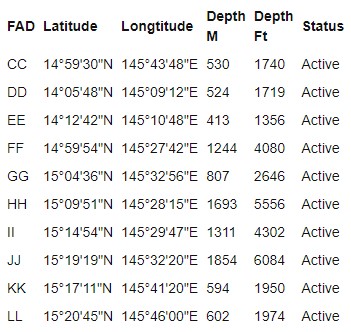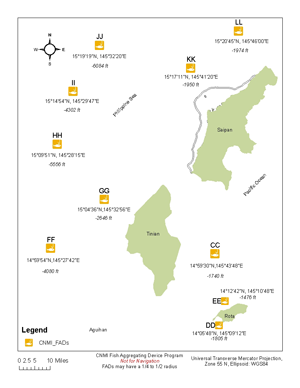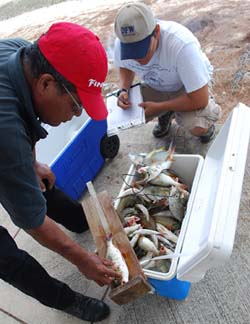Fisheries Research
The Fisheries Research Section (FRS) of the Division of Fish and Wildlife works to collect fisheries independent data and use the fisheries dependent data collected by the Fisheries Data Section for the conservation and management of the aquatic resources of our islands. Much of the funding for these programs comes from the Sport Fish Restoration Program of the U.S. Fish and Wildlife Service. FRS fisheries biologists conduct research, collecting and analyzing multiple types of data to provide policymakers with the information needed to make important conservation decisions. Some of the projects include a Checklist of the Fish of the CNMI, Monitoring of Marine Sanctuaries, Fish Tagging Studies, Evaluation of Management Measures, and a Life History Program.
Fish Aggregating Devices

The CNMI Fish Aggregating Devices (FAD) Program was created to provide both sport and commercial fishermen with a cost-effective way of catching pelagic fish in CNMI offshore waters. FADs are essentially simple structures that provide a home or hiding place for bait fish, thereby creating a feeding ground for fish such as skip jack, yellow fin tuna, wahoo and mahi-mahi. Because they are anchored to the sea floor, FADs allow fishermen to travel directly to productive fishing grounds, minimizing the time and fuel spent searching for schools of fish or flocks of birds. FADs also reduce fishing pressure on reef fishes.
Since the first FADs were deployed in CNMI in 1980 they have been popular with fishermen who report that the FADs not only increase pelagic catch, but "hold the fish longer" allowing increased catch for a longer period of time (mahi-mahi tends to be seasonal in the CNMI). Not only commercial fishermen benefit, the local sport charter boat fleet benefits as well with increased success rates on trips.
How FADs Work
FADS are made out of fiberglass and then filled with foam to obtain maximum buoyancy and stability. A galvanized pipe is used as the core for the buoy and a stainless steel eye-bolt is installed at the bottom portion of the buoy. A chain runs from the eye-bolt to a concrete anchor on the seafloor. As simple as the design is, it creates an environment that attracts fish in an otherwise empty expanse of ocean. FADs are relatively inexpensive compared to other methods of fishing such as long-lining or nets, and they save fishermen a great deal of fuel. Unfortunately, the life span of a FAD is fairly short in the open ocean due to severe environmental conditions, so they require frequent replacement.
Since the first FADs were deployed in CNMI in 1980 they have been popular with fishermen who report that the FADs not only increase pelagic catch, but "hold the fish longer" allowing increased catch for a longer period of time (mahi-mahi tends to be seasonal in the CNMI). Not only commercial fishermen benefit, the local sport charter boat fleet benefits as well with increased success rates on trips.
FAD Locations
The CNMI currently has 10 permanent FAD sites in the waters surrounding the islands of Saipan, Tinian, Aguijan (or Aguiguan) and Rota. They are found 5 to 10 miles from shore in depths of 1,000 to 6,000 feet.


Fisheries Dependent Data Collection

The Division of Fish and Wildlife gathers information on commercial and recreational fishing in the CNMI in order to provide data for making sound fisheries resource management decisions. Both commercial and recreational fish catches are surveyed for quantity, kinds of fish, length and weight measurements as well as the locations, dates and times that fish were caught.
Creel Surveys
Standardized methods have been established for both boat and shore based surveying. Offshore fishing is surveyed via randomly scheduled take counts at various docks and access points. Shore-based surveys are conducted by interviewing fisherman at random times and locations.
Commercial Purchase Invoice System
The Division of Fish and Wildlife has been collecting commercial invoices that include number of fish by type, price and weight filled out by fish vendors, hotels and restaurants when purchasing fish from fishermen since the 1980s. Reporting commercial catch to the Division of Fish and Wildlife has been required since 2012.
Gillnet Special Permits
Gillnet use in CNMI waters was prohibited in 2003 but the Division of Fish and Wildlife has allowed the use of gillnets under special circumstances since 2005. Gillnet use has been allowed on Rota and Tinian for subsistence purposes only since 2011. Authorized netting is monitored and information on catch is reported. See Non-Commercial Fish and Wildlife Regulations for details on allowable net use in the CNMI.
Fishing Derby
The Division of Fish and Wildlife assists in weighing fish caught in various rod & reel and spearfishing tournaments. Fish length and weight measurements are collected.
Checklist of the Fish of CNMI
The Fisheries Research Section has been keeping records of all species identified in the CNMI since 1982. These records come from published literature, FRS surveys, fisherman catches, and other reliable and validated sources. The Checklist of Fishes of the CNMI is an ongoing project. The checklist includes numerous species of pelagic, epipelagic, bottom, reef, and freshwater fish found within the Mariana Archipelago. The checklist is constantly updated as new publications, surveys, and fisherman reports become available. The checklist has been expanded to include offshore banks and reefs for which occurrence data are available.
Fish Life History Program
The Fisheries Research Section of the Division of Fish and Wildlife collects samples from popular food fishes in the CNMI to determine their life history characteristics. Data collected from these fish include length, weight, age, sex, and gonad weight. In addition to these data, the ear bone or otolith of the fish is collected. The fish forms the otolith by laying down layers of calcium periodically. These layers form annual patterns and can be used as a proxy for age of the fish. When the FRS looks at all the data from a particular species the life history strategy of a fish can be determined. Knowing the size, sex and age of fish can help the FRS manage a fish species better by knowing how large or old the species is when it reproduces. Some fish reproduce very early in life while others grow and wait until a later stage in life. These life history strategies can make different fish species react differently to fishing pressure.
Fish Tagging
The FRS is currently working on several fish tagging studies in the CNMI. Fish tagging can produce a myriad of information including movement, growth, and even population size depending on how the study is conducted and the types of tags used. DFW will be attaching two types of tags to fish to gain this information: Conventional tagging using T-bar or dart tags and ultrasonic tagging. Using two methods allows DFW to take advantage of the benefits of each tagging method. It is important to gain local movement data because it gives us information that we can use when adjusting MPAs and making management decisions regarding our fisheries.
Conventional Tagging
A small plastic tag with an ID number and the DFW telephone number is inserted in the fish with a needle. A plastic barb at the end holds the tag in place under the skin. The portion of the tag with the number stays on the outside of the fish. The tag is easily visible if the fish is seen while diving or is caught.
The more fish tagged, the more chance of recapturing a fish with a tag in it. Obtaining good information requires large amounts of tagged fish and a large sampling effort to recapture tagged fish. Habitat and area information is only collected each time a fish is recaptured. This approach provides a potentially large sample size with minimal training needed. It is a relatively cheap method of obtaining habitat use information.
If you see any of these tagged fish, DFW would appreciate you not taking them, so we can get more movement data from the fish. We ask that you let us know if you see one of the tagged fish. If you do take them DFW would like to examine the fish to measure it and remove the tags. The fish will be returned to you promptly after examination.
It is LEGAL to take tagged fish by legal means OUTSIDE any marine protected area but please inform DFW if you do. (670) 664-6044.
Ultrasonic Tagging
Ultrasonic tags are small tags that are inserted into a fish. They emit an ultra-high frequency sound that is picked up by an underwater microphone called a hydrophone. Hydrophones are placed in set areas. When a tagged fish comes within that area, the hydrophone detects the fish and records its presence. Hydrophones are downloaded periodically to collect the data. Fish tagged with ultrasonic tags will also have T-bar tags, so they are easily identifiable as a tagged fish.
Tagging fish with ultrasonic transmitters and monitoring them with an array of hydrophones allows fish to be recorded frequently at multiple locations with minimal influence from the recording process. It only requires periodic downloading of data to monitor the fish. However, it is expensive, requires specialized skills (surgical implantation), and initially has a high time requirement.